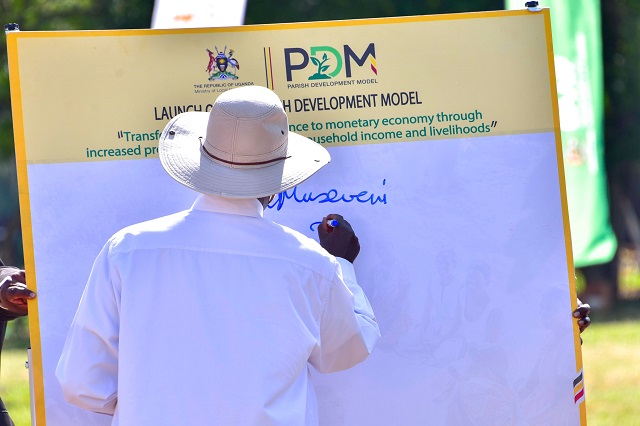
Fronting Revolving Fund as a Flagship is putting the development cart before the horse
COMMENT | WALTER AKENA | In February 2022, Government of Uganda launched the Parish Development Model (PDM). The PDM aims to lift the 39% of Uganda’s population from the subsistence to money economy and has seven pillars of; Production, Storage, Processing and Marketing; Infrastructure and Economic Services; Financial Inclusion; Social Services; Mindset change; Parish Based Management Information System; and Governance and Administration.
In its maiden year, the government has fronted the third pillar of financial inclusion (revolving fund) as a flagship for the PDM and subsequently invested Shs17 million for each parish as revolving fund. While this is commendable, it is akin to putting the cart before the horse. This has caused a misperception among Uganda’s population that the whole model is about the revolving fund. For this reason, the pillar of financial inclusion has effectively eclipsed the other six pillars.
There is a disjointed understanding, appreciation and interpretation of the model with some viewing it as a project and others as a program. This discrepancy is likely going to cause challenges in its implementation.
The PDM was conceptualised as a last mile strategy for service delivery; and improving incomes and welfare of all Ugandans at the household level. Ideally, government should have first invested in popularising the PDM to ensure that there is a common understanding of the model across the different spheres.
There is also another challenge of limited information required for the successful implementation of the model. The approach of PDM entails for instance, creating data systems that constantly feed the whole Government with real time information concerning various interventions at the Parish level. The data are necessary to improve the understanding of the different and unique characteristics of households across the country and hence provide the basis for the delivery of targeted interventions. Unfortunately, there is barely any such information available for all the parishes in the country. Which begs the question of; what modalities would be used to identify groups with viable enterprises to be supported with the revolving funds.
Since the early ‘90s, the government has implemented several poverty eradication programs like Poverty Eradication Action Plan (PEAP), Prosperity for All, Entandiikwa and others-with revolving fund underpinning all these programmes-albeit with minimal results. Prioritising the same under PDM therefore relegates to secondary importance, like was the case in other previous interventions, the role of collective mindset in sustainable development.
No doubt, capital is a factor of production, but knowledge maximises output as noted by United Nations Industrial Development Organisation (UNIDO). If a person has knowledge on how best to organise production, the output is greater. For the PDM to succeed therefore, there should be a deliberate effort to skill the population to increase productivity under the pillar of mindset change.
To maximize the impact of the money invested per parish under the PDM, it is important to have the right mindset and set of skills by the intended beneficiaries. Therefore, deliberate efforts should have been put to massively mobilise the citizens for increased production and agro processing, set parameters for measuring the economic viability of the different groups and decisions to select the beneficiaries for the fund. Citizens need to be equipped with specific skills for poverty alleviation before they are given credit.
There is likely going to be mad dash for the money within the community. Citizens, including those without any productive venture, will scramble for the money and PDM will become another cash bonanza, causing it to collapse just like other interventions before.
Like Abraham Lincoln said; “If I had eight hours to chop down a tree, I’d spend six sharpening my axe.”, government needed to have spent a little more time preparing citizens for the model by; popularising the PDM, developing the parish based information, and creating the right collective mindset.
*****
The writer is a Project Officer, Local Government Council Scorecard Initiative (LGCSCI) at ACODE and can be reached on walter.akena@acode-u.org
 The Independent Uganda: You get the Truth we Pay the Price
The Independent Uganda: You get the Truth we Pay the Price



Ok.
I am happy for the prisdential program
kituufu nyo nyo.. Ugandans tweesiimye. Teri president affaayo kubaantu begwaangalye nga GEN.SHUJAA H.E.Y.K.T.MUSEVENI. Ate mwatu ne mutabaniiwe GEN.MKAINERUGABA Bwaatyo, naye lwaakuba nti 40% ugandans tebanamutegeela, naye 60% buryomu agamba nti GEN.MK ye president Anaasobola ugandans nga H.E.YKMU7 Awumuddeko kubyobufuzi.
wow wow. Thanks you very much
THIS PROGRAM CAN WORK IN OTHER COUNTRIES BUT NOT IN UGANDA WHERE CORRUPTION IS THE ORDER OF THE DAY
This is a very insightful analysis. It has generated meaningful discussions.
For sure to start wiz I thank our president for the work done to serve his country thank you so much.